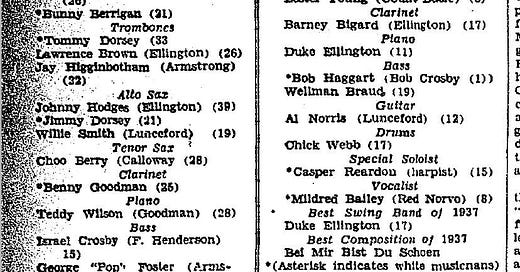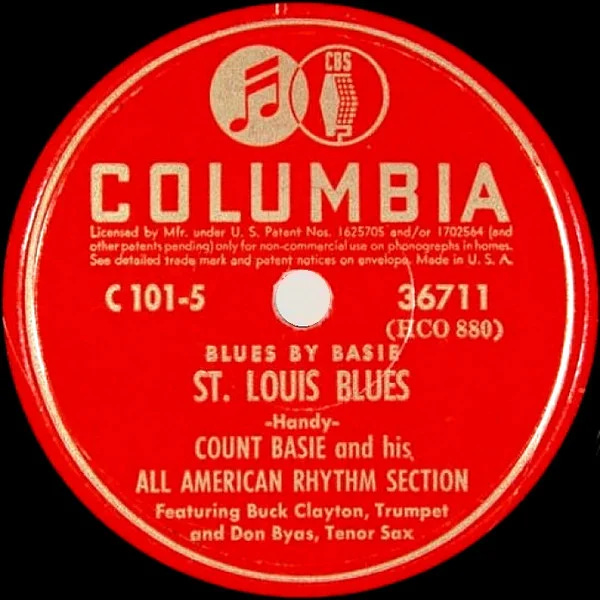The Politics of Swing Era “All-American” Jazz Lists
Basie's Rhythm Section, Paul Whiteman, the Black Press, and More.
The rhythm section that propelled the Basie band from March 1937 until the fall of 1943— Freddie Green on guitar, bassist Walter Page, Jo Jones on drums, and of course Basie on piano — is often cited as one of the best rhythm sections in jazz history (an opinion that I share of course). In fact, somewhere around 1941 they became known as the “All-American Rhythm Section.” “All-American” or “All-America” is a sports term, going back to college football in the 1890s, when authorities started making lists of the best players nationally, and putting them together into fictional “dream teams.”
But when was the term first used in jazz? The earliest use that I know of—so far—is in February 1938, when members of the Associated Negro Press voted for and selected their own “All-American Swing Band” listing. (They did so again in 1939.) White musicians are identified with an asterisk (just as I was identified with an asterisk when I was jazz editor of the journal The Black Perspective in Music, under one of my mentors, the late brilliant Dr. Eileen Southern):
Anthony Barnett, publisher of historic jazz violin recordings at abar.net, tells me that the next usage of “All-American” that he has found in jazz is in reference to Paul Whiteman’s “dream orchestra” in Colliers magazine, September 1938. "The All-America Swing Band,” essentially a listing of Whiteman’s favorite players, was criticized in the black press because only six of the 26 players listed were black — omitting prominent figures like Basie, Duke Ellington, Lester Young, and Coleman Hawkins. Below is a page from The Afro-American reproducing Whiteman’s roster— and critiquing it. The six black artists are highlighted with a larger font. The outspoken nature of this article is typical of the black press, which has been hugely significant in the struggle for equality and in its coverage of jazz, among other things—and, I think, not studied enough by people who write about jazz (not to discount those authors who have spent many hours reading these papers).
It’s a little tricky to follow the text of the article, which announces “War Declared” on Whiteman. (The editors were well aware that in late 1938 such a headline would get the reader’s attention!) It goes down the left side of Eddie South’s photo, then continues on the other side, then continues below the photo. At the bottom of the page, you can read a letter from a fan who gives his own alternate list and ends with a reference to the football origins of the term, asking for other fans to submit their lists of who should “carry the ball”:
(Also on this page are other interesting items: Near the bottom it says that Benny Goodman was once considered to star in Young Man with a Horn! Say what?! Years later, the role went to Kirk Douglas, and the movie was released in 1950. You can also read about Ella Fitzgerald rescuing a dog during a storm while touring as the singer in Chick Webb’s band. And there’s more, but you can take your time looking it over.)
The “War Declared” article says that there’s a response by Lionel Hampton on the same page, but it’s not there, and if that was ever published, I haven’t found it, even though I’ve looked at issues before and after October 1, 1938. (Plans sometimes changed, and besides, there were different editions of The Afro-American in several cities. It is still active today in its home city of Baltimore, with a separate edition for Washington, D.C.) I did find the following article from The Afro-American of June 18, 1938 (p.10) which includes an “all-star” listing by a jitterbug fan and dancer known as Slim Shivers. Although signed by Hampton, it’s not known how much input he really had into this regular column:
Apparently there were objections to this list from John Hammond and other “ickies”—meaning the jazz and swing fanatics who argued about every little thing. So Hampton asked Shivers to compile two more listings that would, they hoped, satisfy everyone. I don’t know Hammond’s complaints (he may have published them somewhere), but I notice that this second list adds Louis Armstrong, corrects Willie Smith’s first name (I’m a big fan of his, as you know from this post), and removes Louise McCarroll (evidently a Harlem-based pianist who Shivers admired, but who never recorded), among other changes. This is from September 17, 1938:
Returning now to the Count Basie band, the expression “All-American Rhythm Section” was reportedly first used in 1941, when Basie appeared with only his rhythm team on The Chamber Music Society of Lower Basin Street, a variety program broadcast on NBC radio. Perhaps the host, or a scriptwriter, came up with the phrase. The show always featured spoken introductions in a pseudo-classical style that was meant to be witty—for example, the host refers to “Doctor Basie” with “Professor Yosef Jones” on drums. I have a bit of this broadcast, but the phrase is not used in the segment that I heard. They do mention that Benny Goodman was one of the rhythm section’s ardent admirers, which is a known detail—in fact, he loved the entire Basie band and Lester Young as well.
To my knowledge, the phrase “All-American Rhythm Section” first appeared in print on the labels of Basie’s small-band session with Don Byas, recorded in 1942 and released two years later. (Thank you for this information to Fernando Ortiz de Urbina, author of jazzontherecord.blogspot.com ) Here is one of the 78rpm labels:
In any case, while it’s a famous expression, “All-American Rhythm Section” doesn’t seem to have been used very much in print. I don't even see it anywhere in Basie’s memoir Good Morning Blues (written with Albert Murray)! And I have to say that I’ve always found it ironic that the term “All-American” was applied to black artists, considering how badly they were treated.
See you again soon!
All the best,
Lewis








I'm a little surprised to learn that Whiteman would be taken this seriously in the black press this late. I don't subscribe to the view that he was a complete charlatan or a person of bad faith, but he seems like someone firmly in the popular music camp who liked a hot solo mostly as a bit of spice--a person who saw his mission as creating high class entertainment that covered all the bases. I guess he still commanded an audience in 1938 and was therefore worth a little press skirmish.